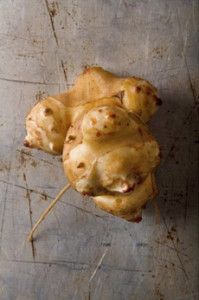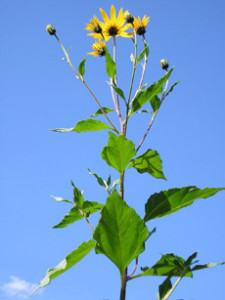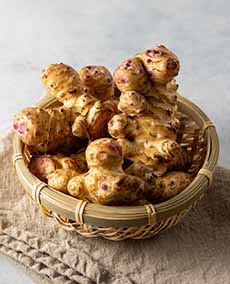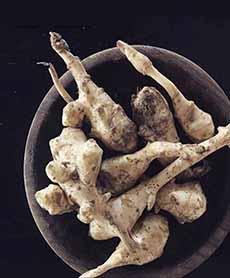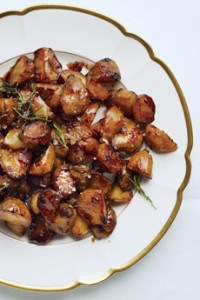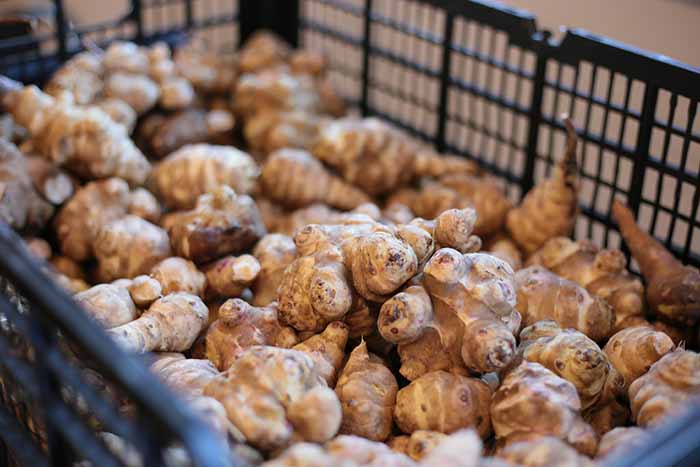Sunchokes (Jerusalem Artichokes) Are In Season: Recipes & History
|
Fresh from California, sunchokes are in season. They’re typically harvested in the fall, around October, after the plant’s flowers have died back. Their flavor gets even better after a light frost. Their autumnal availability makes them a seasonal ingredient for many fall and winter holiday dishes. This brings us to the question: What are sunchokes? Also below: > Sunchoke recipes. Sunchokes, a modern term for Jerusalem artichokes (Helianthus tuberosus) are edible tubers that grow underground, similar to potatoes. The word is a contraction of “sunflower chokes”; sunchokes are close relatives of sunflowers. They are both in the botanical family Asteraceae and the genus Helianthus. Sunchokes taste like a cross between potatoes and artichoke hearts (although they are related to neither), with a slightly nuttiness. Although many people peel them before cooking, we enjoy the earthy flavor of the skins. (We also loved baked potato skins, if that’s any measure.) Root vegetables are generally storage organs, enlarged to store energy in the form of carbohydrates. True roots include: Other root vegetables include: > There is no food holiday for sunchokes, but December is Root Vegetables and Exotic Fruits Month. Jerusalem artichokes are native to eastern North America and were first cultivated by Native Americans, long before the arrival of the Pilgrims and Puritans. The plant grew wild along the eastern seaboard from Georgia to Nova Scotia. The explorer Samuel de Champlain first encountered it in 1605, growing in a Native American vegetable garden in Cape Cod, Massachusetts. The Native Americans called the food sun roots, and introduced them to the Pilgrims, who grew them as a staple food. By the mid-1600s, Jerusalem artichokes had become a common vegetable for human consumption in France, where they were transported by de Champlain. In New England, they were a staple for the settlers. They were also used as livestock feed on both continents. The French worked their culinary magic on the tuber, which reached peak popularity at the turn of the 19th century. But if you fast-forward two centuries, some glory remains: The Jerusalem artichoke was named “best soup vegetable” at the 2002 Nice Festival For The Heritage Of The French Cuisine. [Source] The Jerusalem artichoke is not part of the artichoke family but is a member of the sunflower family. The tall yellow flowers are decorative; the tasty part is the root in the ground. Why is it called Jerusalem, when the Jerusalem artichoke is native to North America? De Champlain felt the tuber tasted like artichokes, and he brought plants back to France with the name Jerusalem artichokes (the modern French name is topinambour). The Puritans referred to their settlement as “New Jerusalem” (after the Book Of Revelations), which may account† for the first part of the name. Around the 1970s, California growers realized that they had a marketing problem with Jerusalem artichoke. Just as the unexciting “prunes” became “dried plums”—and the Patagonian toothfishbecame the very popular Chilean sea bass—a more tantalizing name was sought. A suggestion of “sunflower artichoke” was contracted to sunchoke. Other names include earth apple, and sunroot. Sunchokes can be cooked like potatoes: boiled, fried, grilled, mashed, microwaved or steamed. Raw, it is reminiscent of jicama, and can be added raw to salads. in stir-fries and soups and simply blanched and sauteed with garlic. They can be mashed or blended into mashed potatoes. And there’s nothing like a medley of roasted root vegetables, such as beets, carrots, parsnips, turnips and sunchokes. Here are more elaborate recipes: |
|
|||
|
Before cooking, scrub sunchokes well with a vegetable brush under running water. They can be eaten raw, but have been known to cause gastric upset in some people. It you have a tender tummy, first try a small piece of the raw root. HOW TO BUY SUNCHOKES Choose chokes that are firm, with no soft spots. As with potatoes, avoid nicks or cuts in the peel. Store in a cool, dry place, or keep the sunchokes in the crisper drawer of the fridge, wrapped in a paper towel to absorb excess moisture. One cup of sunchokes has 109 calories, 0 fat or cholesterol, 6 mg sodium, 643 mg potassium, 26 g total carbohydrte, 2.4 g dietary fiber, 14 g sugar and 3g protein. Most significant among vitamins and minerals, one cup contains 10% DV of vitamin C and 28% DV of iron. ____________________ *Parsley root is not related to parsley, the herb, but is a beige root vegetable that resembles a parsnip or turnip. The edible leaves that grow above the ground do resemble curly parsley leaves, but taste like celery. Parsley root is also called turnip-rooted parsley. In Germany it is known as Hamburg parsley, and is a popular winter vegetable in Germany, Holland and Poland. †The Italian word for sunflower is girasole (gee-rah-SO-lay), which could have evolved to “Jerusalem” over time. However, Jerusalem artichokes predated any significant Italian immigration to America by two centuries. A better explanation for the name is that it derives from the Puritans gave their New World settlement: New Jerusalem. CHECK OUT WHAT’S HAPPENING ON OUR HOME PAGE, THENIBBLE.COM. |
||||
